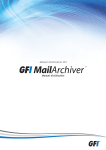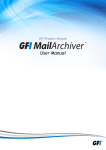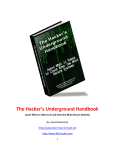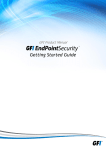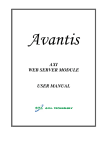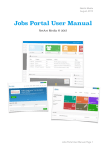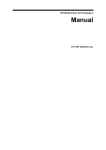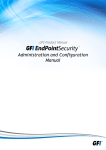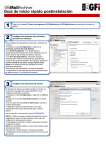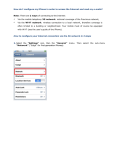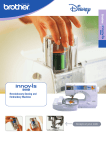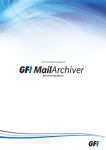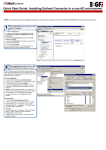Download 1 Using GFI MailArchiver
Transcript
GFI Product Manual
User Manual
The information and content in this document is provided for informational purposes only and is
provided "as is" with no warranty of any kind, either express or implied, including but not limited to
the implied warranties of merchantability, fitness for a particular purpose, and non-infringement.
GFI Software is not liable for any damages, including any consequential damages, of any kind that
may result from the use of this document. The information is obtained from publicly available
sources. Though reasonable effort has been made to ensure the accuracy of the data provided, GFI
makes no claim, promise or guarantee about the completeness, accuracy, recency or adequacy of
information and is not responsible for misprints, out-of-date information, or errors. GFI makes no
warranty, express or implied, and assumes no legal liability or responsibility for the accuracy or
completeness of any information contained in this document.
If you believe there are any factual errors in this document, please contact us and we will review
your concerns as soon as practical.
All product and company names herein may be trademarks of their respective owners. Microsoft
and Windows are either registered trademarks or trademarks of Microsoft Corporation in the
United States and other countries.
GFI MailArchiver® is copyright of GFI SOFTWARE Ltd. - 1999-2012 GFI Software Ltd. All rights
reserved.
Document Version: 2.0.2
Last updated (month/day/year): 12/3/2012
Contents
1 Using GFI MailArchiver
1.1 Logging In GFI MailArchiver
1.2 Browsing Archived Emails
1.3 Working With Emails
1.4 Searching Archived Emails
1.4.1 Advanced Search
1.4.2 Email Search Using Smart Phones
1.5 Accessing Multiple Mailboxes
1.6 GFI MailInsights
1.6.1 Generating Reports
1.6.2 Scheduling Reports
1.6.3 Communication Flow
1.6.4 WebMail Use
1.6.5 Email Responsiveness
1.6.6 Storage Use
1.6.7 Inactive Accounts
1.6.8 Inappropriate Words
1.6.9 Internal Spammers
1.6.10 Outside Office Hours
1.6.11 Data Leakage Detection
1.6.12 Job Search
1.6.13 Phrase Search
1.6.14 User Traffic Report
1.7 Changing User Preferences
2 Configuring Email Client Access
2.1 Installing GFI MailArchiver Outlook Connector
2.2 Downloading and Installing GFI MailArchiver Outlook Addon
2.3 Configuring GFI MailArchiver IMAP Client Access
2.3.1 Configuring IMAP on Android
2.3.2 Configuring IMAP in Apple Mail 3.0
2.3.3 Configuring IMAP in iOS5
2.3.4 Configuring IMAP in Microsoft Outlook® 2003
2.3.5 Configuring IMAP in Microsoft Outlook® 2007
2.3.6 Configuring IMAP in Microsoft Outlook® 2010
2.3.7 Configuring IMAP in Microsoft Outlook 2013
2.3.8 Configuring IMAP in Outlook® 2011 for Mac
2.3.9 Configuring IMAP in Mozilla Thunderbird 10
2.3.10 Configuring IMAP in Windows® Live Mail
4
4
4
6
7
8
9
13
14
15
16
16
19
21
23
25
26
28
31
34
35
37
40
41
43
43
43
44
45
45
47
48
48
49
50
51
52
52
3 Glossary
54
4 Index
59
1 Using GFI MailArchiver
Read this chapter for information related to:
Logging in GFI MailArchiver
Browsing archived emails
Working with emails
Searching for archived emails
Accessing multiple mailboxes
Generating MailInsights reports
Changing the display language and other options
1.1 Logging In GFI MailArchiver
Navigate to Start > GFI MailArchiver > GFI MailArchiver. GFI MailArchiver will load in your
default Internet browser. Key in your domain credentials (username and password used to
login to Windows®) when prompted.
Alternately, from your Internet browser, key in the following URL:
http://<GFI MailArchiver host name>/<GFI MailArchiver virtual folder name>
For example:
http://mydomain.com/MailArchiver
By default, GFI MailArchiver does not require any login credentials while logging in. It will
instead use the credentials of the currently logged in user. Closing your browser session
logs off the currently logged on user from GFI MailArchiver.
NOTE
To login as a different user, log off your profile and log in using a different Windows®
user.
NOTE
If you are logging in from a computer that is not joined to the domain where GFI
MailArchiver is installed, you will be prompted to key in the credentials used to log in
the domain where GFI MailArchiver is installed.
1.2 Browsing Archived Emails
1. From GFI MailArchiver, select Archive tab.
GFI MailArchiver
1 Using GFI MailArchiver | 4
Screenshot 1: Browsing Archived Emails
2. In the Archive tab, you can view emails archived for all the mailboxes that you have been granted
access to. You can also perform several actions as described in the table below.
Table 1: Archive Tab options
OPTION
DESCRIPTION
Enables you to search for emails. Key in the words or phrases to search for
and click . Results are displayed in the emails pane.
Hides the email preview pane.
Shows the email preview pane.
Toggles the email preview pane from displaying emails at the bottom to displaying emails at the side of the email list page.
Displays emails in message view.
Displays emails in mailbox view.
Displays the list of mailboxes the currently logged in user has access to.
From the accounts list, select the Archive Store to view mailboxes for form
the List accounts in archive option. Click Close to exit Account list.
GFI MailArchiver
1 Using GFI MailArchiver | 5
OPTION
DESCRIPTION
Deletes the selected Emails if Email Deletion has been enabled by your
System Administrator. If Email Deletion is not enabled, this icon will not be
displayed.
NOTE
Emails cannot be deleted from Read-only Archive Stores or when
Legal-hold is enabled.
NOTE
By default, GFI MailArchiver displays 25 emails per page. To change this value, click the
user name displayed on the top right hand corner of your screen and change the value of
the Number of emails to display per page option. Click Save.
1.3 Working With Emails
Within the GFI MailArchiver Archive tab, you can view and take action on archived emails. To view an
email, select the email from the mailbox or message view. This will display the selected email in the
preview pane. Double click an email to view it in the email view window.
Screenshot 2: Working with emails within GFI MailArchiver
In the email view window, email contents are displayed and several actions can be performed. These
actions are listed and described in below.
GFI MailArchiver
1 Using GFI MailArchiver | 6
Table 2: Email View options
OPTION
DESCRIPTION
View email headers.
Click to view email Internet headers. These are displayed in a panel. Click this button again or select close
to close panel.
View conversation thread
Click button to view the whole conversation in the mail view window. All emails forming part of the
conversation are listed. Click this button again or select close to close the panel.
Edit email labels (Personal and Global)
Enables you to categorize emails through labeling. This feature is useful during searches for specific mail
types, For example search all emails labeled as “Important”.
To add a label:
1. From ‘Available Labels’, key in a new email label or select an existing one.
2. Click Label Email to label email with the keyed in or selected label.
To remove a previously assigned label:
1. Select a previously assigned label.
2. Click Remove label.
Click this button again or select close to close panel.
NOTE
Labels are displayed in the ‘Labels’ field in black. Labels assigned at an organization level through
categorization policies are in red. You cannot remove categorization policies labels from an email.
Restore email
Restores emails using the OneClick Restore feature that restores an archived email to a specific mailbox or
forwards a copy to an email address.
In the restore email panel, key in the email address where to send a copy of the current email and click
Restore Email.
Save email to disk (EML format)
Downloads the whole email to disk including any attachments, in .eml format. This format is compatible with
a number of email clients such as Microsoft Outlook® Express, Windows® Mail, and Mozilla Thunderbird. In
the File download dialog box, select Save, and select the location where to save the file.
Save email to disk (MSG format)
Downloads the whole email to disk including any attachments, in .msg format, which is compatible with
Microsoft Outlook®. In the File download dialog box, select Save, and select the location where to save the
file.
Print email
Displays email in a printer friendly format in a new browser window. Use the print function of your browser
to print the email.
Show images in email
Use this button to display embedded images within the email.
Mark as not SPAM
Use this button to mark as not SPAM an email that was previously identified as SPAM by an anti-spam
solution. Requires a SPAM retention policy to be set up
Delete Email
Deletes the current email if Email Deletion has been enabled by your System Administrator. If Email
Deletion is not enabled, this icon will not be displayed.
NOTE
Emails cannot be deleted from Read-only Archive Stores or when Legal-hold is enabled.
1.4 Searching Archived Emails
Within GFI MailArchiver, you can search for emails using the Search Archived Emails text box. When
searching for emails, GFI MailArchiver will query the email index retrieve any matching email and its
GFI MailArchiver
1 Using GFI MailArchiver | 7
respective attachment.
Apart from the Search Archived Emails text box, GFI MailArchiver also provides you with an
Advanced Search feature that provides an extensive range of search options.
NOTE
For more information, refer to Advanced Search (page 8).
In the Search Archived Emails text box, you can also use wildcards as described in the table below.
Table 3: Wildcard description
WILDCARD
DESCRIPTION
?
Matches any single character.
*
Matches any string of characters.
For example:
To search for emails containing the word ‘Swiss’, key in ‘sw??s’ or ‘sw*s’ in the Archived Emails text
box.
Emails matching the search query are displayed in the emails pane. GFI MailArchiver displays up to 25
emails per page. If more than 25 emails are matched for each search query, GFI MailArchiver will
spread the emails out on separate pages. Use the slider at the bottom of the email pane to change
from one page to the next.
1.4.1 Advanced Search
The Advanced Search is an extension of the Search feature that enables you to use a wide range of
search criteria when searching for emails.
1. From the Archive tab, select
.
Screenshot 3: Advanced Search Options
2. In the Advanced Search Options area, use the features described in the table below to perform an
advanced search.
Table 4: Advanced Search options
OPTION
DESCRIPTION
Archive Store
Defines the Archive Store where the search will be performed. Select one or more Archive Stores
from the available list of Archive Stores.
Sent date
Defines the date when the email to search for was sent.
GFI MailArchiver
1 Using GFI MailArchiver | 8
OPTION
DESCRIPTION
Includes all/any
Defines whether to display emails that match all conditions or emails that match any of the
conditions. From the drop-down list select:
All – Displays emails that match at least one of the conditions specified.
Any – Displays emails that meet all the conditions specified.
Click this button to add conditions. Available conditions are:
Subject – Search for emails having a specific subject.
Sender - Specify the email address or Active Directory® display name of the email sender for
which to search emails.
Recipient - Specify the email address or Active Directory® display name of the email recipient for which to search emails.
Sent Date - Search for emails sent before, after or exactly on a specific date. Key in or
select a date, and select Is before, Is after or Is exactly.
Received Date - Search for emails received before, after or exactly on a specific date. Key
in or select a date, and select Is before, Is after or Is exactly.
Size (KB) - Search for emails that are bigger, smaller or equal to a particular size. Key in a
size and select Is greater than, Is smaller than and Is exactly.
Message ID - Search using the ‘Message ID’ field contained in the email header. Key in or
paste the message ID of the email to find.
Whole Email - Search for emails that have some specific content anywhere in the email
(including the body, headers and attachments).
Body - Search for emails that have some specific content in the body.
Attachment - Search for emails that have some specific content anywhere in the attachment.
Folder - Search for emails contained in a specific mailbox folder.
Folder/Subfolders - Search for emails contained in a specific subfolder within a mailbox
folder.
Label - Search for emails categorized with a specific label.
NOTE
Click
Exclude emails
with the following
conditions
next to a search condition to remove it.
Defines a list of conditions that the email will NOT have to meet to be returned as a search
result. Click and select the conditions to apply. The conditions that can be selected are similar
to the ones described above.
NOTE
Click
next to a search criteria to remove it from search.
Search
Starts the search for the archived emails. Results are returned as per the conditions selected.
Reset
Resets the search conditions and enables you to start all over again.
Save
Saves the search conditions as a saved search query that can be triggered at any time. Saved
searches are displayed in the Classifications window under Archive tab.
1.4.2 Email Search Using Smart Phones
Within GFI MailArchiver, you can search for emails using a smart phone.
GFI MailArchiver
1 Using GFI MailArchiver | 9
NOTE
This feature is supported by the following mobile Operating Systems:
Android 2.1+
Apple iPhone iOS 4
Blackberry OS5+
To perform a simple search:
1. Launch the Internet browser on your smart phone and key in the URL where GFI MailArchiver is
located in the following format:
http://<GFI MailArchiver host name>/<GFI MailArchiver virtual folder name>
For example:
http://mydomain.com/MailArchiver
Screenshot 4: Smart Phone Login Screen
2. Sign in using your credentials.
GFI MailArchiver
1 Using GFI MailArchiver | 10
Screenshot 5: GFI MailArchiver Home Page for Smart Phones
NOTE
The Mobile User Interface uses the same language settings as those configured by the
user in GFI MailArchiver. For more information, refer to Changing User Preferences
(page 41).
3. Key in the text to search for and click Search.
GFI MailArchiver
1 Using GFI MailArchiver | 11
Screenshot 6: Search Result by Smart Phone
4. Browse through the displayed results using the controls provided. Results are sorted by date in
descending order.
NOTE
The mobile search feature returns 10 emails per page. You can browse additional pages
using the controls provided. The maximum number of results is 5000.
GFI MailArchiver
1 Using GFI MailArchiver | 12
Screenshot 7: Conversation View Smart Phone
5. Click the Email subject to display the email or click View Conversation to display related emails.
NOTE
The mobile user interface is focused on searching email archives. For advanced search
and browsing features, access GFI MailArchiver from your computer.
NOTE
The mobile user interface enables users to access ONLY their mailbox.
1.5 Accessing Multiple Mailboxes
From within the Archive tab, you can also browse other users’ archived emails. The users for which
you can access emails depend on the access granted from the GFI MailArchiver Access Control
feature.
NOTE
Search user to add feature is disabled if currently logged on user does not have access
to other user’s mailboxes, or if there are no emails to view.
GFI MailArchiver
1 Using GFI MailArchiver | 13
Screenshot 8: Accessing multiple mailboxes
To view archived emails for a different mailbox:
1. Key in the name of the mailbox for which to view emails in the Search users to add search box . A
list of names matching the one keyed and for which you have access to will be displayed.
2. Select the user and click
next to the search field.
3. Select the newly added user from the Browse conversations for: field.
4. Browse or search the displayed emails using the controls provided.
1.6 GFI MailInsights
GFI MailInsights is a reporting facility within GFI MailArchiver that uses archived emails to deliver
information related to email usage and trends. Use this feature to generate management and HR
reports that provide insight on email and resource use or misuse.
NOTE
GFI MailInsights is only enabled for users with full access rights.
The available reports are:
GFI MailArchiver
1 Using GFI MailArchiver | 14
Communication Flow – Monitor user/group communication patterns inside and outside the organization.
WebMail Use - Identify top users exchanging email with webmail services. Identifies potential data
leakages and inappropriate email use.
Email Responsiveness - Gain insight into the average time it takes users to reply to internal and
external email.
Storage Use - Understand the impact of attachments on email storage costs. Use this report to
create appropriate retention policies to control email-related storage space.
Inactive Accounts - Returns a list of user accounts that received email but have not replied within
the specified time.
Inappropriate Words - Track inappropriate language in email that violates company policy.
Internal Spammers - Find out which internal users tend to include too many recipients in the
To/CC/BCC fields. Use this report to know about and minimize such behavior.
Outside Office Hours - Returns a list of internal mail accounts with sending activity outside office
hours. Use this report to spot behavior which may need more investigation
Data Leakage Detection - Identify emails with major credit card numbers and US Social Security
numbers, or other confidential documents and information.
Job Search - Identify sent or received emails that contain resumes, or are addressed to job search
sites.
Phrase Search - Search for specific terms or phrases within archived emails.
User Traffic - View the number of emails exchanged between selected users or groups and their
contacts.
1.6.1 Generating Reports
Generated reports are sent by email either to the logged in user or to a user specified in the Send To
field. Reports are sent as an attachment in PDF format.
To generate a report:
1. Select MailInsights tab and choose desired report.
2. Use available filters by selecting a value to filter by.
3. (Optional) In the Forward to field, enter the recipient email address.
NOTE
When using the email forwarding option, the report is received by the user generating
the report and by any users specified in the Forward to field.
NOTE
You can insert multiple email addresses separated by ';'
4. Click Send Report, located at the bottom of each report page.
GFI MailArchiver
1 Using GFI MailArchiver | 15
1.6.2 Scheduling Reports
Every MailInsights report can be scheduled to run automatically.
To schedule a report:
1. Select MailInsights tab and choose desired report.
2. Use available filters by selecting a value to filter by.
3. Click Schedule.
Screenshot 9: MailInsights report scheduling
4. In the Report Name field, enter a meaningful name for your report.
5. (Optional) In the Forward to field, enter the recipient (or recipients) email address.
6. From the Schedule Report drop down list, select the report run frequency. Available options
are: Daily, Weekly or Monthly.
7. In the At field, specify the time.
8. Click Save & Schedule Report.
1.6.3 Communication Flow
The Communication Flow graph provides an overview of emails exchanged between selected
users/groups and their contacts.
GFI MailArchiver
1 Using GFI MailArchiver | 16
Screenshot 10: MailInsights Communication Flow
Filter the report using the following criteria:
Table 5: Communication Flow Report criteria
OPTION
DESCRIPTION
Scope
Specify date range or use default setting. You can only select dates in the last 6 months.
Report for
Select Active Directory® user or group.
Recipients
Select Internal, External or All.
Include
Specify number of results up to a maximum of 1000 recipients. Default value is Top 20.
GFI MailArchiver
1 Using GFI MailArchiver | 17
Screenshot 11: MailInsights Communication Flow Report
Senders can be a user or group displayed as a single entity in the middle of the report. Contacts are
segregated by domains. Each domain cluster is shown in different color. Edge width between the
nodes shows the strength of the email relation between different entities.
The table below the graph shows the following information:
GFI MailArchiver
1 Using GFI MailArchiver | 18
Table 6: Communication Flow Report criteria
OPTION
DESCRIPTION
Contact Email
Contact email address
Sent Emails
Total number of sent emails
Received Emails
Total number of received emails
Total Emails
Total number of sent and received emails
Last Communication
Date and time of last sent/received email.
For further information, refer to:
Generating MailInsights reports
Scheduling MailInsights reports
1.6.4 WebMail Use
The WebMail Use area enables you to generate a report that shows interaction of internal users with
web email accounts.
Screenshot 12: MailInsights WebMail Use
The report can be filtered using the following criteria:
Table 7: WebMail Use Report criteria
OPTION
DESCRIPTION
Scope
Specify date range or use default setting. You can only select dates in the last 6 months.
Report for
Select Active Directory® user or group.
Include
Specify number of results up to a maximum of 1000 recipients, default value is Top 20.
GFI MailArchiver
1 Using GFI MailArchiver | 19
Screenshot 13: MailInsights WebMail Communicators Report
The graph represents total emails sent and received in specified period. A Summary area at the top of
the report shows the top WebMail providers, with a summary of sent and received emails per
provider.
The table below the graph contains the following information:
Table 8: WebMail Use Report criteria
OPTION
DESCRIPTION
User
User email address.
Total Emails
Total number of internal contacts.
Sent Emails
Total number of sent emails.
Received Emails
Total number of received emails.
Average/Day
Average emails sent and received per day.
Total Percentage
Percentage of total web emails.
GFI MailArchiver
1 Using GFI MailArchiver | 20
NOTE
WebMail Use report covers the following WebMail providers: Hotmail; Gmail; Yahoo!;
Live; AOL; Facebook; Yandex.ru; Seznam.cz; Gawab.com; Gmx.com; Mail.ru;
Hushmail.com; Rediff.com
For further information, refer to:
Generating MailInsights reports
Scheduling MailInsights reports
1.6.5 Email Responsiveness
The Email Responsiveness report shows how long it takes employees to reply to emails.
Screenshot 14: MailInsights Email Responsiveness
Filter the report using the following criteria:
Table 9: Email Responsiveness Report criteria
OPTION
DESCRIPTION
Scope
Specify date range or use default setting (Last 7 days). You can only select dates in the last 6 months.
Report for
Select Active Directory® user or group.
Include
Specify number of results up to a maximum of 1000 recipients, default value is All.
Sort By
Specify sorting method. Options are:
By name (default)
By responsiveness
GFI MailArchiver
1 Using GFI MailArchiver | 21
Screenshot 15: MailInsights Email Responsiveness Report
The bar chart represents users on the y-axis and responsiveness in hours on the x-axis. Data is sorted
according to defined criteria.
Additional data is displayed in a table below the chart with the following information:
Table 10: Email Responsiveness Report criteria
OPTION
DESCRIPTION
User
Name or email address of user
Average responsiveness
All Email (Hours)
Average Internal responsiveness
Internal Email (Hours)
Average external responsiveness
External Email (Hours)
For further information, refer to:
Generating MailInsights reports
Scheduling MailInsights reports
GFI MailArchiver
1 Using GFI MailArchiver | 22
1.6.6 Storage Use
The Storage Use report shows how much space is used by different attachment categories.
Screenshot 16: MailInsights Storage Use
Filter report using the following criteria:
Table 11: Email Storage Report criteria
OPTION
DESCRIPTION
Scope
Specify date range or use default setting (This Month). You can only select dates in the last 6 months.
Report for
Select Everyone (default), Active Directory® user or group
GFI MailArchiver
1 Using GFI MailArchiver | 23
Screenshot 17: MailInsights Storage Use Report
The graph consists of stacks representing different attachment categories. The graph’s x-axis shows
the different size brackets and the y-axis shows the attachment size.
NOTE
Attachment categories for Storage Use report are: Images, Documents, Music, Videos
and Others
The table below the graph contains the following additional information:
Table 12: Storage Use Report criteria
OPTION
DESCRIPTION
Date
Date email was received.
Total Size (KB)
Total size of attachment.
Images (KB)
Total size of attachment for category Images.
GFI MailArchiver
1 Using GFI MailArchiver | 24
OPTION
DESCRIPTION
Documents (KB)
Total size of attachment for category Documents.
Music (KB)
Total size of attachment for category Music.
Videos (KB)
Total size of attachment for category Videos.
Other (KB)
Total size of attachment for category Other.
For further information, refer to:
Generating MailInsights reports
Scheduling MailInsights reports
1.6.7 Inactive Accounts
The Inactive Accounts area enables you to generate a report that shows internal accounts that are no
longer active.
Screenshot 18: MailInsights Inactive Accounts
Filter report using the following criteria:
Table 13: Inactive Accounts Report criteria
OPTION
DESCRIPTION
Scope
Specify date range or use default setting (Last 30 days). You can only select dates in the last 6 months.
GFI MailArchiver
1 Using GFI MailArchiver | 25
Screenshot 19: Inactive Accounts Report
NOTE
An inactive account is an account that has received emails but has not sent any emails
in the date range covered.
The report returns a list of inactive accounts.
For further information, refer to:
Generating MailInsights reports
Scheduling MailInsights reports
1.6.8 Inappropriate Words
The Inappropriate Words area enables you to generate a report that identifies any inappropriate
language used in emails. Inappropriate words can include words considered sexist, racist or swear
words.
GFI MailArchiver
1 Using GFI MailArchiver | 26
Screenshot 20: MailInsights Inappropriate Words
Filter the report using the following criteria:
Table 14: Inappropriate Words Report criteria
OPTION
DESCRIPTION
Scope
Specify date range or use default setting (Today). You can only select dates in the last 6 months.
Recipients
Select All, Internal Only, External Only
GFI MailArchiver
1 Using GFI MailArchiver | 27
Screenshot 21: MailInsights Inappropriate Words Report
NOTE
When the Inappropriate Words report exceeds 1,500 rows, the report will be generated
in .xls format.
Report data is displayed in a table listing the following:
Table 15: Inappropriate Words Report criteria
OPTION
DESCRIPTION
Date/Time
Email date and time
Sender
Sender email address
Subject
Email subject
For further information, refer to:
Generating MailInsights reports
Scheduling MailInsights reports
1.6.9 Internal Spammers
The Internal Spammers report enables you to generate a list that identifies internal email accounts
of users who include a large number of recipients in their emails. This reports takes into
consideration recipients in the To, CC or BCC fields.
GFI MailArchiver
1 Using GFI MailArchiver | 28
Screenshot 22: MailInsights Internal Spammers
Filter the report using the following criteria:
Table 16: Internal Spammers Report criteria
OPTION
DESCRIPTION
Scope
Specify date range or use default setting (Last 30 days). You can only select dates in the last 6 months.
Include
Specify the amount of email accounts to include up to a maximum of 1000 users.
GFI MailArchiver
1 Using GFI MailArchiver | 29
Screenshot 23: MailInsights Internal Spammers Report
Report data is displayed in a table listing the following:
Table 17: Internal Spammers Report criteria
OPTION
DESCRIPTION
Username
Sender username or email address.
Average Number of Recipients
Average number of recipients who received email from the sender during the specified
time period.
For further information, refer to:
Generating MailInsights reports
Scheduling MailInsights reports
GFI MailArchiver
1 Using GFI MailArchiver | 30
1.6.10 Outside Office Hours
Use this report to identify internal users who send emails outside of office hours.
Screenshot 24: MailInsights Outside Office Hours
Filter the report using the following criteria:
Table 18: Outside Office Hours Report criteria
OPTION
DESCRIPTION
Report
for
Enables you to choose for whom this report applies. Run report on all employees (default) or on an Active
Directory® group.
Include
Specify number of results to display, up to a maximum of 1000. Default = 50.
Scope
Specify date range or use default setting (This Month). You can only select dates in the last 6 months.
GFI MailArchiver
1 Using GFI MailArchiver | 31
OPTION
DESCRIPTION
Office
Hours
Enter a time range according to your organization's normal working hours.
Working
Week
Select the days of work of your organization. Checked days are considered as part of normal office hours.
NonWorking
Days
Use the calendar to define non-working days for past and future dates. Selected dates are listed in the
provided window. Non-working days can include public holidays and company shutdown.
IMPORTANT
The settings will only be saved upon successful generation of the report. If you navigate away from the
page before generating the report, all settings will be lost.
NOTE
When using the Clear All Dates button, configured dates will be cleared for all years.
The following examples describe how the report will work when configured in typical scenarios:
Scenario 1: An organization working from Monday to Friday, with start time and end time within the
same day, example from 9.00 am to 6.00 pm.
The report will cover emails sent between 6.00 pm and 9.00 am from Monday to Friday, and all day
during Saturday and Sunday.
Scenario 2: An organization working from Monday to Friday. Start time and end time span across
midnight, example from 8.00 pm to 5.00 am.
In this case the report will cover emails sent between 5.00 am and 8.00 pm from Monday to Friday
and those sent on Saturday and Sunday. Emails sent on Saturdays between midnight and 5.00 am will
not be taken into account, since they are considered within normal working hours.
Scenario 3: An organization working from Monday to Friday. Start time and end time span across
midnight, Wednesday is a public holiday.
The report will cover emails sent between 5.00 am and 8.00 pm from Monday to Friday, emails sent
on Saturday and Sunday, and all emails sent on Wednesday from midnight to midnight.
GFI MailArchiver
1 Using GFI MailArchiver | 32
Screenshot 25: MailInsights Outside Office Hours Report
The results of the generated report are displayed in a horizontal bar chart. A report summary above
the chart displays the top 3 users who sent emails outside office hours.
Additional data is displayed in a table below the chart with the following information:
Table 19: Outside Office Hours Report criteria
OPTION
DESCRIPTION
Email
Email address of user
Number of Emails Sent
Number of emails sent outside office hours
For further information, refer to:
Generating MailInsights reports
Scheduling MailInsights reports
GFI MailArchiver
1 Using GFI MailArchiver | 33
1.6.11 Data Leakage Detection
Use this report to detect emails that potentially contain sensitive data. The report will detect sent or
received emails containing:
Major credit card numbers (VISA, Mastercard, American Express, Diner’s Club, Discover)
USA Social Security numbers
Confidential documents and information
NOTE
The report analyzes both sent and received email for a selected user.
Screenshot 26: MailInsights Data Leakage Detection report
Filter the report using the following criteria:
Table 20: Data Leakage Detection Report criteria
OPTION
DESCRIPTION
Scope
Specify date range or use default setting (Last 3 Months). You can only select dates in the last 6 months.
Report for
Enables you to choose for whom this report applies. Run report on all employees (default) or on an Active
Directory® user or group.
Recipients
Internal recipients, external recipients or both. Default is both.
GFI MailArchiver
1 Using GFI MailArchiver | 34
Screenshot 27: MailInsights Data Leakage Detection Report
The results of the generated report are listed in a table sorted by date in ascending order. A report
summary above the table displays the top 3 senders.
The table contains the following information:
Table 21: Data Leakage Detection Report criteria
OPTION
DESCRIPTION
Date
Displays the date and time of the email.
Sender
Sender email address.
Subject
Email subject.
NOTE
Entries in the subject column contain a link to display the detected email.
Leakage Type
Leakage type can be: Credit card, Social Security Number, confidential data, medical,
NOTE
If more than one type of leak is detected, only the first one is displayed.
For further information, refer to:
Generating MailInsights reports
Scheduling MailInsights reports
1.6.12 Job Search
Use this report to identify internal users who exchange emails with job search sites. The report
detects sent or received emails containing resumes.
NOTE
The report is able to identify both sent and received email for a selected user.
GFI MailArchiver
1 Using GFI MailArchiver | 35
Screenshot 28: MailInsights Job Search report
Filter the report using the following criteria:
Table 22: Job Search Report criteria
OPTION
DESCRIPTION
Scope
Specify date range or use default setting (This Month). You can only select dates in the last 6 months.
Report
for
Enables you to choose for whom this report applies. Run report on all employees (default) or on an Active
Directory® user or group.
Domains
The list of domains listed in this area will be added to the search criteria of the report. Add domains by
typing the URL in the available field and clicking . To remove a domain, click . Clear all removes all the
listed URLs.
The default list of job search sites includes: Monster.com; Jobster.com; jobcentral.com; hotjobs.yahoo.com;
careerbuilder.com; indeed.com; simplyhired.com; jobing.com; reed.co.uk; jobsearch.co.uk; monster.co.uk;
totaljobs.com; fish4.co.uk; cityjobs.com.
GFI MailArchiver
1 Using GFI MailArchiver | 36
Screenshot 29: MailInsights Job Search Report
The results of the generated report are listed in a table sorted by date in ascending order. A report
summary above the table displays the top 3 users who exchanged emails with job search domains.
The table contains the following information:
Table 23: Job Search Report criteria
OPTION
DESCRIPTION
Date
Displays the date and time of the email.
Sender
Sender email address.
Subject
Email subject.
NOTE
Entries in the subject column contain a link to display the detected email.
For further information, refer to:
Generating MailInsights reports
Scheduling MailInsights reports
1.6.13 Phrase Search
Search for specific terms or phrases within archived emails using the Phrase Search report. The
report runs search queries on whole email bodies to detect emails containing the specified terms and
displays results as a pie chart or stacked line graph.
NOTE
The report detects phrases in both sent and received email for a selected user or group.
GFI MailArchiver
1 Using GFI MailArchiver | 37
Screenshot 30: MailInsights Phrase Search report
Filter the report using the following criteria:
Table 24: Phrase Search Report criteria
OPTION
DESCRIPTION
Scope
Specify date range or use default setting (This Month). You can only select dates in the last 6 months.
Report
for
Enables you to choose for whom this report applies. Run report on all employees (default) or on an Active
Directory® user or group.
Chart
Type
Choose between a Pie chart and Stacked Bar graph. The pie chart displays the total percentage of emails for
the results found while the stacked line graph displays the count of emails sent on a day-by-day basis.
Phrases
Phrases can be composed of 1 or more words. Use quotes (") to search for exact phrases or enter words
without quotes to search for any of the words entered. A limit of 10 phrases ensures the report does not
consume too many resources or take too long to run.
GFI MailArchiver
1 Using GFI MailArchiver | 38
Screenshot 31: MailInsights Phrase Search Report
The results of the generated report are listed in a table sorted by date in ascending order. A report
summary above the table displays the total number of emails, and the total emails that matched a
phrase.
The table contains the following information:
Table 25: Phrase Search Report criteria
OPTION
DESCRIPTION
Date
Displays the date and time of the email.
Sender
Sender email address.
Subject
Email subject.
NOTE
Entries in the subject column contain a link to display the detected email.
Phrase
The phrase that was part of the search.
For further information, refer to:
Generating MailInsights reports
Scheduling MailInsights reports
GFI MailArchiver
1 Using GFI MailArchiver | 39
1.6.14 User Traffic Report
The User Traffic graph provides an overview of the number of emails exchanged between selected
users or groups and their contacts. It also lists unique email addresses of sent or received email.
Screenshot 32: MailInsights User Traffic
Filter the report using the following criteria:
Table 26: MailInsights User Traffic Report criteria
OPTION
DESCRIPTION
Scope
Specify date range or use default setting. You can only select dates in the last 6 months.
Report for
Select Active Directory® user or group.
GFI MailArchiver
1 Using GFI MailArchiver | 40
Screenshot 33: MailInsights User Traffic Report
The selected mailbox can belong to a user or group (displayed at the top of the report). Different
colors denote whether the emails were Sent, Received, Internal, Inbound or Outbound.
The table below the graph shows the following information:
Table 27: User Traffic Report criteria
OPTION
DESCRIPTION
Email Address
Contact email address
Sent
Total number of sent emails
Received
Total number of received emails
Internal
Total number of sent and received emails
Inbound
Total number of inbound email.
Outbound
Total number of outbound email.
For further information, refer to:
Generating MailInsights reports
Scheduling MailInsights reports
1.7 Changing User Preferences
1. Click the user name displayed on the upper right hand corner of the screen.
GFI MailArchiver
1 Using GFI MailArchiver | 41
Screenshot 34: User profile preferences
2. From the Language options drop down box, select the language to display.
3. From the Maximum page size area, configure the number of emails to display per page.
4. From the Audit Reports Date/Time Format area (available only if logged in as an administrator),
change the date/time format to display on audit reports.
5. Click Save.
GFI MailArchiver
1 Using GFI MailArchiver | 42
2 Configuring Email Client Access
GFI MailArchiver provides integration with various email clients and technologies so that users can
access their archived emails from remote locations, while in the office or on the move. Use the Email
Client Access page to:
Download GFI MailArchiver Outlook Connector, a Microsoft Outlook® plugin that enables users to
view archived emails from their Microsoft Outlook client.
Download GFI MailArchiver Outlook Addon, a tool that enables users to manually archive emails
contained in their Microsoft Outlook® installation.
Configure an IMAP account on your email client of choice to view archived emails in mailboxes you
have access to.
In this chapter:
2.1 Installing GFI MailArchiver Outlook Connector
The GFI MailArchiver Outlook Connector enables users to synchronize their Microsoft Outlook® folders
with the data archived by GFI MailArchiver.
1. Open GFI MailArchiver.
2. Select Email Client Access tab.
3. Click Outlook Connector tab.
4. Select one of the available download options link to download GFI MailArchiver Outlook Connector.
Available options are:
Table 28: GFI MailArchiver Outlook Connector versions
OPTION
DESCRIPTION
Outlook Connector (32-bit Outlook)
Download the GFI MailArchiver Outlook Connector for Microsoft Outlook 32-bit version.
Outlook Connector (64-bit Outlook)
Download the GFI MailArchiver Outlook Connector for Microsoft Outlook 64-bit
version.
5. Double click on the file and follow the wizard to install
6. To check installation, from Microsoft Outlook, check that a new folder called GFI MailArchiver
Mailbox is created.
NOTE
For information on how to use the GFI MailArchiver Outlook Connector, refer to the GFI
MailArchiver Outlook Connector manual available from:
http://www.gfi.com/mar/manual/
2.2 Downloading and Installing GFI MailArchiver Outlook Addon
The GFI MailArchiver Outlook Addon can be downloaded from the GFI MailArchiver web interface.
GFI MailArchiver
2 Configuring Email Client Access | 43
IMPORTANT
GFI MailArchiver Outlook Addon is not available for download if Manual Archiving is not
enabled. For more information refer to Configuring Archiving Method.
1. Open GFI MailArchiver.
2. Click Email Client Access tab.
3. From Manual Archiving area, click Download Outlook Addon.
4. Double click the downloaded file and follow the wizard to install.
NOTE
To verify successful installation, check that GFI MailArchiver Outlook Addon toolbar is
visible within Microsoft Outlook®.
2.3 Configuring GFI MailArchiver IMAP Client Access
GFI MailArchiver supports a number of e-mail clients that use IMAP to transfer archived e-mail
messages from the Archive Stores to the email client. Users are able to access a read-only view of
their archived emails using one of the following supported email clients:
Android email application
Apple Mail
iOS5 email application
Microsoft Outlook® 2003
Microsoft Outlook® 2007
Microsoft Outlook® 2010
Microsoft Outlook® 2013
Microsoft Outlook® 2011 for Mac
Mozilla Thunderbird
Windows® Live Mail
NOTE
Internet Message Access Protocol (IMAP) is an Internet protocol for e-mail retrieval.
When IMAP is enabled for the first time, you may notice a delay until your email client
synchronizes with GFI MailArchiver to retrieve archived emails.
Viewing Shared Mailboxes
As a user with access to other users' mailboxes, you can use your IMAP account to view the shared
mailboxes you have access to. To do this, you need to configure a new account for each shared
mailbox. Follow the instructions on how to create a new IMAP client account in the email client of
GFI MailArchiver
2 Configuring Email Client Access | 44
your choice, however, as a username, type your username in the following format: <your email
address> ¦ <user email address> using your own password.
IMPORTANT
To configure email clients to use IMAP, you must first configure the IMAP Server.
In this chapter:
2.3.1 Configuring IMAP on Android
Follow these instructions to configure IMAP on Android devices:
NOTE
The following configuration requires an Internet connection.
1. Launch Email client and select option to create a new IMAP email account.
2. Configure the following Incoming Mail Server settings:
OPTION
VALUE
Email Address:
[full email address]
Password:
[your password]
3. In Manual setup mode, enter the following information:
OPTION
VALUE
Username:
[full email address]
Password:
[your password]
IMAP server:
[IMAP server name]
Port:
Use the default port number 44143 or the port number specified by your Systems Administrator.
Security type:
Select the Security type provided by your Systems Administrator.
NOTE
If Security Type is set to None, your connection to the IMAP server will be unencrypted.
4. After entering your IMAP configuration parameters, the device checks your incoming settings.
5. When prompted, enter Outgoing server settings supplied by your System Administrator. The device
checks your outgoing settings.
NOTE
Configuration instructions depend on your Android OS version. Consult your device
documentation for more information on how to set up a new IMAP account.
2.3.2 Configuring IMAP in Apple Mail 3.0
Follow these instructions to configure IMAP in Apple Mail 3.0:
GFI MailArchiver
2 Configuring Email Client Access | 45
NOTE
The following configuration requires an Internet connection.
1. Click Mail > Preferences....
2. On the Accounts tab, click the + button to add a new account.
3. Enter the following information:
OPTION
VALUE
Full Name:
[your name]
Email Address:
[full email address]
Password:
[your password]
4. Click Continue.
5. Enter the following Incoming Mail Server information:
OPTION
VALUE
Account Type:
Select IMAP
Description
Enter account description
Incoming Mail Server:
imap.gfi.com
User Name:
[full email address]
Password:
[your password]
6. Click Continue to view the Incoming Mail Security screen.
7. Select Use Secure Sockets Layer (SSL) to connect to GFI MailArchiver using an encrypted
connection.
NOTE
If SSL is not enabled, the connection will be unencrypted.
8. Enter the following Outgoing Mail Server information:
OPTION
VALUE
Outgoing Mail Server:
smtp.gfi.com
Use Authentication:
selected
User Name:
[User name]
Password:
[your password]
9. Click Continue.
10. Review your Account Summary, and click Create.
11. Select the account you just created.
12. In the Advanced tab, enter the following information:
OPTION
VALUE
Port
Use the default port number 44143 or the port number specified by your Systems Administrator.
Use SSL
Select to connect to GFI MailArchiver using an encrypted connection.
GFI MailArchiver
2 Configuring Email Client Access | 46
2.3.3 Configuring IMAP in iOS5
Follow these instructions to configure IMAP in iOS5:
NOTE
The following configuration requires an Internet connection.
1. Tap Settings and select Mail, Contacts, Calendars.
2. In the Accounts section, tap Add Account.
3. From the list, select Other.
4. Select Add Mail Account and enter the following information:
OPTION
VALUE
Name:
[your name]
Address:
[full email address]
Password:
[your password]
Description:
[meaningful description]
5. Tap Next. The device will connect to the Internet and check your account.
6. Select IMAP and enter the following information:
INCOMING MAIL SERVER DETAILS:
VALUE
Host Name:
[IMAP server name]
User Name:
[full email address]
Password:
[your password]
OUTGOING MAIL SERVER DETAILS:
VALUE
Host Name:
[SMTP server name]
User Name:
[User name]
Password:
[your password]
NOTE
Outgoing Mail Server details must be provided by your Systems Administrator.
7. Tap Next. If you receive an error indicating that you Cannot Connect Using SSL, tap Yes to
continue without SSL, then tap Save.
NOTE
SSL can be configured after you save the new email account. If SSL is not enabled, the
connection will be unencrypted.
8. From Mail, Contacts, Calendars, locate the account you created under the Accounts section.
9. Tap the account name, scroll to Advanced.
GFI MailArchiver
2 Configuring Email Client Access | 47
10. Under Incoming Settings, change Server Port number to the default port number 44143 or the
port number specified by your Systems Administrator.
11. Tap Use SSL to turn it on.
12. Tap Next. The device will verify the information you entered.
2.3.4 Configuring IMAP in Microsoft Outlook® 2003
1. Start Outlook®.
2. On the Tools menu, click E-mail Accounts.
3. Under E-mail Accounts, click Add a new e-mail account, and then click Next.
4. Click IMAP as the type of account that you are creating, and then click Next.
5. In the User Information section enter the following information:
OPTION
VALUE
Your Name:
[your name]
E-mail Address:
[full e-mail address]
6. In the Server Information section enter the following information:
OPTION
VALUE
Incoming mail server (IMAP):
[IMAP Server name]
Outgoing mail server (SMTP):
[SMTP server name provided by your Systems Administrator]
7. In the Logon Information section enter the following information:
OPTION
VALUE
User Name:
[full e-mail address]
Password:
[your password]
8. Click More Settings > Advanced enter the following information:
OPTION
VALUE
Incoming server (IMAP):
Use the default port number 44143 or the port number specified by your
Systems Administrator.
This server requires an encrypted
connection
Select this option to connect using an encrypted connection.
NOTE
If SSL is not enabled, the connection will be unencrypted.
9. Click Next after you have completed entering this configuration information, and then click Finish.
2.3.5 Configuring IMAP in Microsoft Outlook® 2007
1. Start Outlook®.
2. On the Tools menu, click Options.
3. On the Mail Setup tab, click Email Accounts.
4. Click New.
5. In the Auto Account Setup dialog box, select Manually configure server settings or additional
server types, then click Next.
6. Click Internet E-Mail, and then click Next.
GFI MailArchiver
2 Configuring Email Client Access | 48
7. In the User Information section enter the following information:
OPTION
VALUE
Your Name:
[your name]
E-mail Address:
[full e-mail address]
8. In the Server Information section enter the following information:
OPTION
VALUE
Account Type:
IMAP
Incoming mail server:
[IMAP server name]
Outgoing mail server (SMTP):
[SMTP server name provided by your Systems Administrator]
9. In the Logon Information section enter the following information:
OPTION
VALUE
User Name:
[full e-mail address]
Password:
[your password]
10. Click More Settings > Advanced enter the following information:
OPTION
VALUE
Incoming server (IMAP):
Use the default port number 44143 or the port number specified by your
Systems Administrator.
Use the following type of encrypted
connection:
Select the encryption method provided by your Systems Administrator.
NOTE
If prompted, accept the Security Certificate.
NOTE
If ‘NONE’ is selected as the type of encryption, the connection will be unencrypted.
11. Click Next after you have completed entering this configuration information, and then click
Finish.
2.3.6 Configuring IMAP in Microsoft Outlook® 2010
1. Start Outlook®.
2. On the File menu, click Info, then click Account Settings.
3. Select Account Settings from the list.
4. On the E-mail tab, click New.
5. Select the Manually configure server settings or additional server types check box, and then click
Next.
6. Click Internet E-Mail, and then click Next.
7. In the User Information section enter the following information:
OPTION
VALUE
Your Name:
[your name]
E-mail Address:
[full e-mail address]
8. In the Server Information section enter the following information:
GFI MailArchiver
2 Configuring Email Client Access | 49
OPTION
VALUE
Account Type:
IMAP
Incoming mail server:
[IMAP server name]
Outgoing mail server (SMTP):
[SMTP server name provided by your Systems Administrator]
9. In the Logon Information section enter the following information:
OPTION
VALUE
User Name:
[full e-mail address]
Password:
[your password]
10. Click More Settings > Advanced enter the following information:
OPTION
VALUE
Incoming server (IMAP):
Use the default port number 44143 or the port number specified by your
Systems Administrator.
Use the following type of encrypted
connection:
Select the encryption method provided by your Systems Administrator.
NOTE
If prompted, accept the Security Certificate.
NOTE
If ‘NONE’ is selected as the type of encryption, the connection will be unencrypted.
11. Click Next after you have completed entering this configuration information, and then click
Finish.
2.3.7 Configuring IMAP in Microsoft Outlook 2013
1. Start Outlook®.
2. On the File menu, click Info, then click Account Settings.
3. Select Account Settings from the list.
4. On the E-mail tab, click New.
5. Select the Manually configure server settings or additional server types check box, and then click
Next.
6. Click Internet E-Mail, and then click Next.
7. In the User Information section enter the following information:
OPTION
VALUE
Your Name:
[your name]
E-mail Address:
[full e-mail address]
8. In the Server Information section enter the following information:
OPTION
VALUE
Account Type:
IMAP
Incoming mail server:
[IMAP server name]
Outgoing mail server (SMTP):
[SMTP server name provided by your Systems Administrator]
9. In the Logon Information section enter the following information:
GFI MailArchiver
2 Configuring Email Client Access | 50
OPTION
VALUE
User Name:
[full e-mail address]
Password:
[your password]
10. Click More Settings > Advanced enter the following information:
OPTION
VALUE
Incoming server (IMAP):
Use the default port number 44143 or the port number specified by your
Systems Administrator.
Use the following type of encrypted
connection:
Select the encryption method provided by your Systems Administrator.
NOTE
If prompted, accept the Security Certificate.
NOTE
If ‘NONE’ is selected as the type of encryption, the connection will be unencrypted.
11. Click Next after you have completed entering this configuration information, and then click
Finish.
2.3.8 Configuring IMAP in Outlook® 2011 for Mac
Follow these instructions to configure IMAP Outlook® 2011 for Mac:
1. Open Outlook® 2011.
2. If you see a Welcome to Outlook® screen, click Add Account. Otherwise click Tools > Accounts and
click + in the menu bar.
3. Click E-mail Account.
4. Enter the following information:
OPTION
VALUE
Email Address:
[full email address]
Password:
[your password]
User Name:
[full email address]
Type:
Select IMAP
Incoming Server:
[IMAP server name]
Select Override default port and enter
port number:
Use the default port number 44143 or the port number specified by your
Systems Administrator.
Use SSL to connect (recommended)
Select to connect to GFI MailArchiver using an encrypted connection.
NOTE
If SSL is not enabled, the connection will be unencrypted.
Outgoing Server:
[SMTP server name provided by your Systems Administrator]
NOTE
Un-select Configure Automatically.
5. Click Add Account.
GFI MailArchiver
2 Configuring Email Client Access | 51
6. In the Accounts window, click on More Options and set Authentication to Use Incoming Server
Info.
7. Click Advanced and select Use IMAP IDLE (If the server supports it) to be notified when there are
new messages.
8. Click OK.
2.3.9 Configuring IMAP in Mozilla Thunderbird 10
Follow these instructions to configure IMAP in Mozilla Thunderbird 10:
1. In Thunderbird, select File > New > Mail Account.
2. In the Mail Account Setup screen enter the following information:
OPTION
VALUE
Your name:
[first and last name]
Email address:
[full email address]
Password:
[your password]
3. Click Continue.
NOTE
Click Stop to prevent Thunderbird from automatically detecting account settings, then
click Manual config.
4. In Mail Account Setup, enter the following information:
OPTION
VALUE
Incoming:
From the drop down menu, select IMAP.
Server hostname:
[IMAP server name]
Port:
[use default]
SSL:
Select the encryption type provided by your Systems Administrator.
NOTE
If SSL is not enabled, the connection will be unencrypted.
Authentication:
[Normal password]
Outgoing:
[Use settings provided by your Systems Administrator]
5. Click Advanced Config and under the account name locate Server Settings. Enter the following
information:
OPTION
VALUE
Port:
Use the default port number 44143 or the port number specified by your Systems Administrator.
Username:
[full email address]
6. After Thunderbird verifies the account information, click Create Account.
7. Click Get Mail to download emails.
2.3.10 Configuring IMAP in Windows® Live Mail
1. Open Windows® Live Mail and from the Accounts tab, click Email.
2. In the Add your email accounts window enter the following information:
GFI MailArchiver
2 Configuring Email Client Access | 52
OPTION
VALUE
Email Address:
[full email address]
Password:
[your password]
Manually configure server settings:
[Selected]
3. Click Next.
4. In the Configure server settings window enter the following information:
OPTION
VALUE
Incoming server information:
Server type:
[port number]
Server address:
[IMAP server name]
Port:
Use the default port number 44143 or the port number specified by your Systems
Administrator.
Requires a secure connection
(SSL):
Select to connect to GFI MailArchiver using an encrypted connection.
NOTE
If SSL is not enabled, the connection will be unencrypted.
Authenticate using:
[Clear text]
Outgoing server information:
[Use details provided by your Systems Administrator]
5. Click Next, then click Finish.
GFI MailArchiver
2 Configuring Email Client Access | 53
3 Glossary
A
Access privileges
Permissions granted to users or group of users to perform various operations on diverse
emails.
Active Directory
A technology that provides a variety of network services, including LDAP-like directory services.
AD
See Active Directory
Archive Store management
A GFI MailArchiver technology that enables you to queue and schedule the archive stores to
use according to different time periods.
Archive Stores
A collection of email sources, email metadata and search indexes within GFI MailArchiver
C
Categorization policies
A categorization system within GFI MailArchiver that enables the categorization of email
according to its label.
Conversation thread
A list of emails forming a conversation between two or more users.
D
Database Activity Auditing
A system that uses the tracing capabilities of Microsoft SQL server to record all activity within
an archive database.
Database schema
The structure of a database that defines the tables, the fields in such tables and the relationship between fields and tables.
E
Exchange OLE DB provider
A method used to access the local Microsoft Exchange Server store by using OLE DB and Microsoft ADO.
GFI MailArchiver
3 Glossary | 54
Exchange System manager
A specialized MMC console that enables you to manage your Exchange organization.
ExOLEDB
See Exchange OLE DB provider
F
Firebird database
An open source relational database system.
G
GFI MailArchiver Import Service
A GFI MailArchiver tool that imports email data from file to the GFI MailArchiver.
GFI MailArchiver Outlook Connector
A GFI MailArchiver tool that enables you to synchronize Microsoft Outlook folders with the
email data archived by GFI MailArchiver.
GFI MailInsights
A reporting facility within GFI MailArchiver that leverages archived emails to deliver information related to email usage and trends.
GPO
See Group Policy Objects
Group Managers
A user group within GFI MailArchiver that members can browse and search through all users
forming part of their Active Directory group.
Group Policy Objects
An Active Directory centralized management and configuration system that controls what
users can and cannot do on a computer network.
H
Headers
Information that precedes the email text (body). This includes the sender, recipient, subject,
sending and receiving time stamps, etc.
I
IMAP
See Internet Message Access Protocol
GFI MailArchiver
3 Glossary | 55
Internet Message Access Protocol
One of the two most commonly used Internet standard protocols for e-mail retrieval, the
other being POP3.
J
Journaling
A Microsoft Exchange Server feature which stores email copies in a central mailbox for various
purposes, incl. mail archiving.
M
Mailbox
A directory or folder used for receipt, filing, and storing messages of emails.
Mailbox folder structure retrieval
A GFI MailArchiver feature that enables you to synchronize the mailbox folder structure in
Microsoft Exchange with GFI MailArchiver
MAIS
See GFI MailArchiver Import Service
MAPI
See Message Application Programming Interface
Message Application Programming Interface
A messaging architecture and a Component Object Model based API for Microsoft Windows.
Metadata
Data that provides information about email archived within GFI MailArchiver.
Microsoft SQL Server
A Microsoft relational database management system.
MIME
See Multipurpose Internet Mail Extensions
Mixed authentication mode
An SQL server authentication method that enables both Windows and SQL Server authentication.
Multipurpose Internet Mail Extensions
A standard that extends the format of e-mail to support text other than ASCII, non-text
attachments, message bodies with multiple parts and header information in non-ASCII character sets.
GFI MailArchiver
3 Glossary | 56
O
OneClick Restore
A user-friendly method of restoring archived emails to the user s inbox and either restores
emails as it was at the time of deletion or sends it to user as an email attachment.
Outlook Web Access
Microsoft Exchange Server s webmail service. Used to access email, contacts, tasks, etc.
using a web interface when Microsoft Office Outlook is unavailable.
OWA
See Outlook Web Access
P
POP3
See Post Office Protocol ver.3
Post Office Protocol 3
A protocol used by local email clients to retrieve emails from mailboxes over a TCP/IP connection.
PST exporter
An agent-based tool that once deployed on the target computers, extracts emails from PST
files for processing by the GFI MailArchiver Import Service.
PST file
A file used to store local copies of email, calendar events, contacts and other items within
Microsoft Office Outlook.
Public folders
A common folder shared between Microsoft Exchange a user, which enables information sharing.
R
Retention Policies
A system that enables you to control for how long to keep specific emails in your archive
stores.
S
Search index
A system that collects parses and stores data to enable fast and accurate information
retrieval.
GFI MailArchiver
3 Glossary | 57
U
User interaction auditing
A system that enables you to record all users activity while they are using the GFI MailArchiver web interface.
GFI MailArchiver
3 Glossary | 58
4 Index
A
Access Control 13
Active Directory 9, 17, 19, 21, 23, 31, 34, 36, 38, 40
archive 8, 13
C
categorization policies 7
D
Documentation 45
G
GFI MailInsights
Generating reports 14
Glossary 54
H
headers 7, 9
I
IMAP 43-45, 47-52
L
labeling 7
M
mailboxes 4-5, 13, 44
O
OneClick Restore 7
R
recipient 9
Retention policies 15
U
User preferences 41
GFI MailArchiver
Index | 59
USA, CANADA AND CENTRAL AND SOUTH AMERICA
15300 Weston Parkway, Suite 104 Cary, NC 27513, USA
Telephone: +1 (888) 243-4329
Fax: +1 (919) 379-3402
[email protected]
UK AND REPUBLIC OF IRELAND
Magna House, 18-32 London Road, Staines-upon-Thames, Middlesex, TW18 4BP, UK
Telephone: +44 (0) 870 770 5370
Fax: +44 (0) 870 770 5377
[email protected]
EUROPE, MIDDLE EAST AND AFRICA
GFI House, San Andrea Street, San Gwann, SGN 1612, Malta
Telephone: +356 2205 2000
Fax: +356 2138 2419
[email protected]
AUSTRALIA AND NEW ZEALAND
83 King William Road, Unley 5061, South Australia
Telephone: +61 8 8273 3000
Fax: +61 8 8273 3099
[email protected]




























































